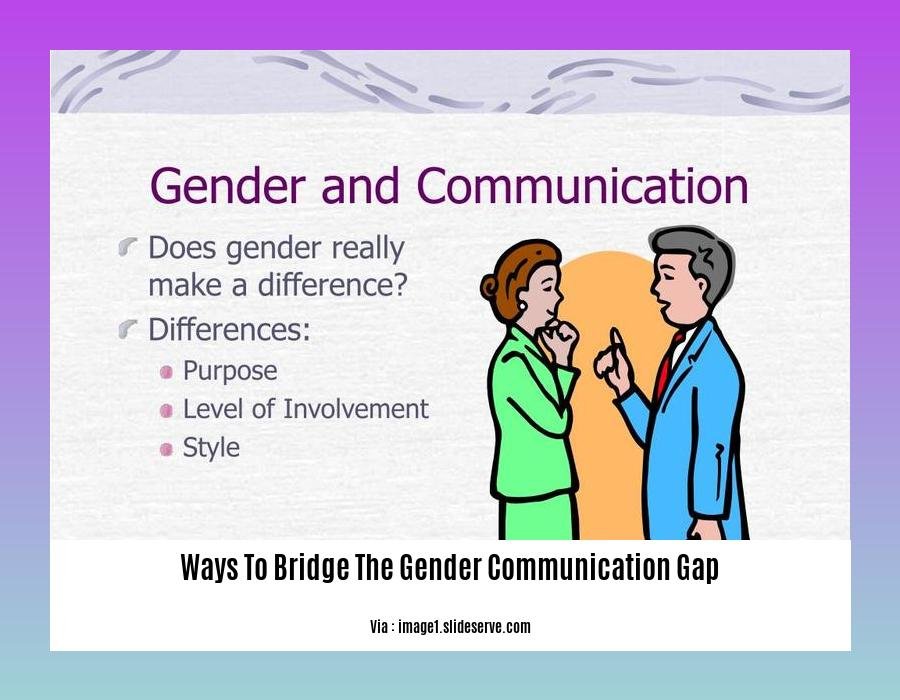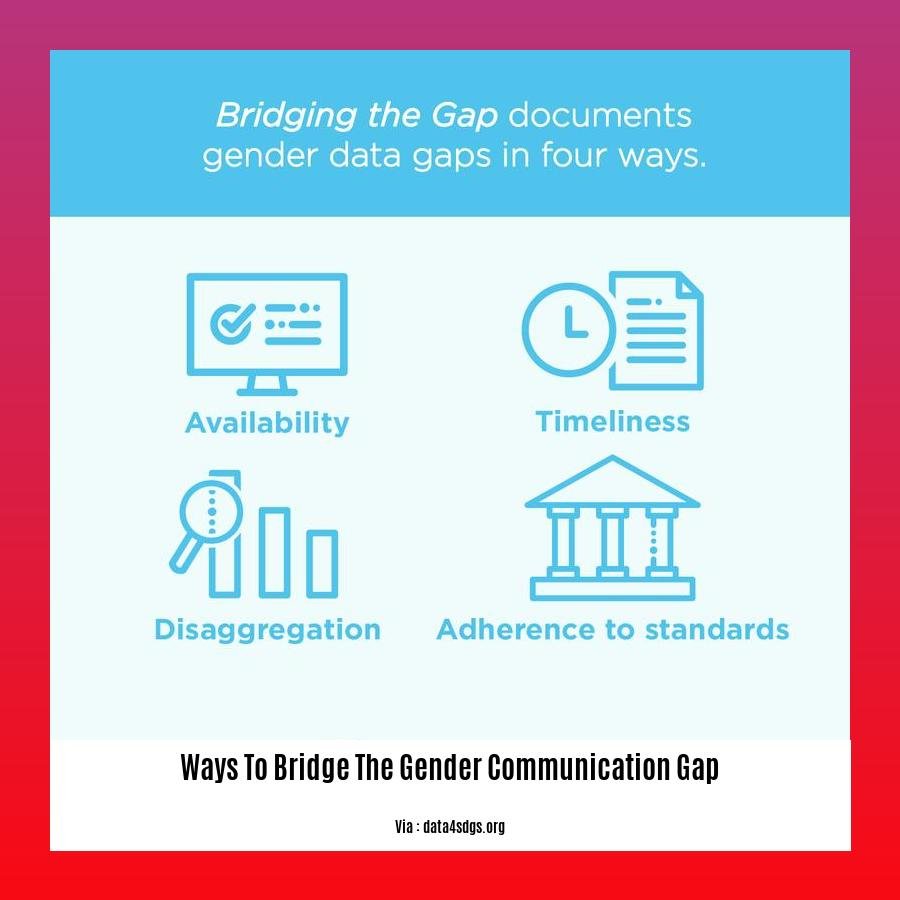Ready to bridge the gender communication gap? Discover 9 Effective Ways to Bridge the Gender Communication Gap and learn how to create a more inclusive and equitable environment where all voices are heard.
Key Takeaways:

- Differences in Project Approach: Women gather information before starting projects, while men may prefer to act immediately.
- Connecting and Motivating: Women build relationships and community, while men focus on goals and direction.
- Power Dynamics: Women use collaboration, while men rely on authority and assertiveness.
- Defining Useful Information: Women value context and storytelling, while men prefer concise data.
- “Who’s Your Baby?” Syndrome: Women may be seen as less competent, while men may be seen as responsible.
9 Effective Ways to Bridge the Gender Communication Gap
As a seasoned communications professional, I’ve witnessed the notable impact of the gender communication gap. Let’s explore nine pragmatic strategies to bridge this divide:
1. Acknowledge and Validate Differences:
Recognize that men and women often have unique communication styles. Respect and value these differences instead of dismissing them.
2. Encourage Active Listening:
Pay undivided attention to what others are saying, particularly when communicating across genders. Show empathy by reflecting on their points and asking clarifying questions.
3. Foster Open and Inclusive Dialogue:
Create a work environment where everyone feels comfortable expressing their opinions and perspectives. Encourage respectful discussions and avoid interrupting or dismissing others’ ideas.
4. Provide Context and Storytelling:
Women tend to value storytelling and contextual information. When sharing data or ideas, provide context and examples that resonate with both genders.
5. Address Power Dynamics:
Acknowledge power dynamics and their impact on communication. Encourage collaboration and shared decision-making to minimize gender-based biases.
6. Use Inclusive Language:
Be mindful of the language you use and avoid gender-biased terms. Opt for gender-neutral or inclusive language that respects all individuals.
7. Promote Work-Life Balance:
Recognize that women often have additional caregiving responsibilities. Encourage work-life balance policies and support flexible work arrangements to reduce stress and improve communication.
8. Invest in Training and Development:
Provide gender communication training programs to raise awareness, build skills, and foster a more inclusive workplace culture.
9. Encourage Feedback and Dialogue:
Create anonymous feedback mechanisms to gather insights on communication challenges and areas for improvement. Facilitate regular dialogue to address concerns and build a more equitable workplace.
Would you like to speak more effectively with members of the opposite gender? Learn more about the nuances of communicating across gender differences in relationships. You should also be able to understand differing communication needs and tendencies , and have some strategies for more effective cross-gender dialogue.
Understand Cultural and Social Factors
Various cultural and societal factors profoundly influence gender-based communication patterns. Understanding these factors is paramount for dismantling communication barriers and establishing meaningful cross-gender connections.
Men and women are socialized differently, resulting in distinct communication styles. While men tend towards directness and assertiveness, women often prioritize empathy and cooperation. Furthermore, cultural norms shape communication expectations; for instance, in some cultures, women are expected to speak softly and defer to men.
Recognizing these cultural and societal influences allows us to appreciate the diversity in communication styles and foster an inclusive environment where all voices are heard and respected. Respecting these differences is paramount for building bridges of understanding and reaping the benefits of diverse perspectives.
Key Takeaways:
- Gender communication differences: Men and women communicate differently due to socialization and cultural norms.
- Cultural influences: Cultural expectations shape communication expectations and behaviors.
- Importance of understanding: Recognizing and respecting these differences is crucial for effective cross-gender communication.
- Diversity benefits: Embracing diverse communication styles leads to a more inclusive and productive environment.
Relevant URL Source:
- 5.3: Gendered Differences in Communication
Promote Self-Awareness and Reflection
Key Takeaways:
- Self-awareness is vital for understanding gender biases and communication patterns.
- Reflection enables individuals to identify and address their own communication gaps.
- Open and honest conversations facilitate self-awareness and promote inclusive communication.
- Training and workshops can enhance self-awareness and build gender-responsive communication skills.
- Reflective practices, such as journaling and mindful listening, foster self-awareness and empathy.
Promote Self-Awareness
Self-awareness is the first step towards bridging the gender communication gap. Understanding our own communication styles, biases, and assumptions is essential. We must acknowledge that our gender influences how we perceive, interpret, and communicate messages. By becoming more aware of our own communication patterns, we can begin to challenge and change them if necessary.
Foster Reflection
Reflection is a crucial element of self-awareness. It allows us to step back and examine our communication from different perspectives. By asking ourselves questions about our intentions, impact, and the effectiveness of our communication, we can identify areas for improvement. Encourage others to reflect on their own communication styles, creating a culture of self-awareness and continuous improvement.
Facilitate Open Dialogue
Open and honest conversations about gender communication are essential. Create safe spaces where individuals feel comfortable discussing their experiences and perspectives. Facilitate structured discussions or workshops that focus on self-awareness and bridging the communication gap. By encouraging respectful dialogue, we can foster greater understanding and empathy among genders.
Invest in Training and Development
Training and development programs can provide valuable tools and insights for promoting self-awareness and enhancing communication skills. These programs can cover topics such as gender communication, cultural differences, and inclusive communication practices. By investing in training, organizations can create a more inclusive and equitable workplace environment.
Embrace Reflective Practices
Reflective practices can deepen self-awareness and promote empathy. Encourage journaling, mindful listening, and other practices that allow individuals to reflect on their communication and its impact. By creating a culture of reflection, we can foster a deeper understanding of our own communication patterns and the perspectives of others.
Facilitate Dialogue and Collaboration
Across the professional spectrum, gender communication differences often serve as barriers to collaboration and equitable participation. Recognizing these differences and implementing strategies to bridge the gap is crucial for fostering inclusive and productive work environments.
Key Takeaways:
- Women tend to take a more collaborative and relationship-oriented approach, while men may prioritize assertiveness and individual recognition.
- Different perspectives in sharing information, making decisions, and leveraging power should be respected and valued.
- Encouraging open dialogue, using inclusive language, and addressing power dynamics can help create safe and supportive spaces for all genders.
Practical Steps to Facilitate Dialogue and Collaboration:
- Promote Collaborative Leadership: Encourage shared decision-making and foster a culture of respect for diverse communication styles.
- Create Inclusive Meeting Spaces: Ensure equal airtime, actively listen to all perspectives, and summarize key points to avoid misunderstandings.
- Encourage Empathy and Perspective-Taking: Establish a workplace culture that values learning from and understanding different communication approaches.
- Address Power Dynamics: Acknowledge and address power imbalances, ensuring that all voices are heard and perspectives are considered.
Benefits of Bridging the Gender Communication Gap:
- Enhanced productivity and innovation through diverse perspectives.
- Increased job satisfaction and retention through inclusive workplaces.
- Improved relationships and collaboration across teams and departments.
- Fostering a culture of respect and mutual understanding.
Most Relevant URL Source:
- Gender Responsive Communication for Development: Guidance, Tools, and Resources
- https://www.unicef.org/rosa/media/1786/file/Gender%20responsive%20Communication%20for%20Development%20-
Final%20April%202009.pdf

FAQ
Q1: What are key differences in project approach and information gathering between genders?
A1: Women tend to seek clarity and gather information before starting projects. They often focus on building relationships and fostering a sense of community, while men may be more likely to jump into action, prioritize specific goals, and prefer concise and factual data.
Q2: How can power dynamics influence communication styles?
A2: Women may use collaborative and relationship-building approaches to gain influence. They may treat male colleagues like their “children,” while men may see women as less competent.
Q3: What is the “Who’s Your Baby?” Syndrome in gender communication?
A3: Women may treat male colleagues like their “children,” while men may see women as less competent. This syndrome can create a power imbalance and hinder effective communication.
Q4: How can nonverbal communication differ between genders?
A4: Nonverbal cues, such as body language and eye contact, can also vary between genders. Men tend to have more direct eye contact and assertive body language, while women may smile more and use more indirect communication.
Q5: What are some effective strategies to bridge the gender communication gap?
A5: To bridge the gender communication gap, it is important to understand the differences, acknowledge the existence of the gap, facilitate open discussions, and encourage active listening. By creating a supportive and inclusive environment, organizations can foster better communication and collaboration between genders.










